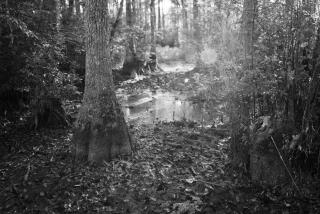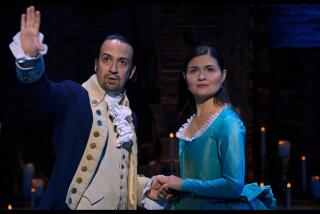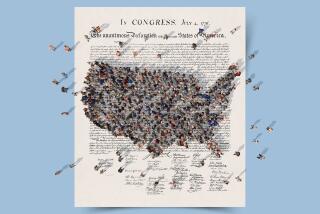The Shot Heard ‘Round the World
The American Revolution and the longevity of the political system it created appear in retrospect so inevitable that we sometimes forget what remarkable achievements they actually were. No republican government had ever before consolidated its authority over so vast a geographical area. The statesmen of the revolutionary generation deserve enormous credit for the success of the American experiment in nation-building and self-government. This, at least, is Joseph J. Ellis’ argument in “Founding Brothers,” which was recently awarded the Pulitzer Prize in history.
Ellis, who teaches at Mount Holyoke College in Massachusetts, is best known for “American Sphinx,” his study of Thomas Jefferson, and for publicly changing his opinion about Jefferson’s purported relationship with his slave Sally Hemings when DNA evidence indicated that he had fathered at least some of her children. (Like most Jefferson scholars, Ellis was initially skeptical, but in this book, he reiterates that Jefferson’s paternity has been established “beyond any reasonable doubt.”) Loosely modeled on Lytton Strachey’s classic “Eminent Victorians,” ’Founding Brothers” is less a history of the revolutionary era than a series of “stories” meant to illustrate the characters and beliefs of the period’s most prominent political leaders, among them John Adams, Alexander Hamilton, Jefferson, James Madison and George Washington. But although Strachey’s title was ironic and his sketches deconstructed, as it were, his subjects’ pretensions and reputations, Ellis has composed a valentine to the founders.
Human that generation certainly was, with prejudices, passions and blind spots. Those who turn from our own sordid politics to seek in the past a pristine time of disinterested statesmanship will not find much support in this book. During the 1790s, Ellis points out, “the political wheeling and dealing inside Congress” reached such epidemic proportions that Madison acquired the unofficial title “Big Knife” because of his success in cutting deals. The political culture was intensely partisan and political invective even more scurrilous than during Bill Clinton’s presidency.
On the other hand, Ellis’ abundant quotations from his subjects’ writings--notably the exchange of letters between Adams and Jefferson that began in 1812 and ended with their deaths in 1826--stand in sharp contrast to the political prose of our own era, when leaders seem incapable of producing a grammatical sentence, let alone a speech of soaring rhetoric. And his “stories” make the point that the founding era, unlike ours, was a time when American statesmen debated questions that went to the root of the society’s present and future. The era’s passions reflected, above all, profound differences about how the fruits of independence should be secured and what kind of nation the new United States should be.
“Founding Brothers” begins less than auspiciously, with a detailed account of the maneuverings leading up to the 1804 duel with Aaron Burr that cost Hamilton his life. Though interesting in its own right, the chapter seems to have little purpose other than to demonstrate Burr’s recklessness. But when Ellis moves on to the other founders, his careful exposition of events and controversies illuminates the politics of the early republic.
Ellis uses a famous 1790 dinner--at which Jefferson brokered a political bargain whereby Southerners accepted Hamilton’s plan for federal assumption of state debts in exchange for the establishment of a permanent capital on the banks of the Potomac River--to explore rival visions of America’s economic future. Hamilton believed that the new nation must mobilize its resources under the guidance of the federal government and tie its economic future to the self-interested energies of its most dynamic business leaders: bankers, merchants and other members of the urban elite. Jeffersonians believed the future lay with westward expansion and the consolidation of an agrarian republic, not with commerce and manufacturing. They feared that Hamilton’s fiscal plan was creating the very institutions--a national bank, national debt and all-powerful national state--that had led Britain down the road to tyranny and corruption.
In a chapter on the drafting of Washington’s farewell address (actually a public letter, never delivered orally), Ellis illustrates the close working relationship between Hamilton and the first president and ruminates on Washington’s indispensable role as both symbol and creator of national unity. By examining the changes in Hamilton’s successive drafts, Ellis shows how he managed to express Washington’s innermost beliefs more effectively than the president himself. His prose was more elegant and epigrammatic than Washington’s, but when he tried to slip some of his own opinions into the address, the president corrected him in no uncertain terms. And Washington’s decision to relinquish office voluntarily after serving two terms--the occasion for the address--established a powerful precedent for how political leadership in a republic would differ from that in the world’s monarchies.
Within its self-defined limits, “Founding Brothers” is remarkably successful. Ellis writes in a lucid, unhurried style and with a sure command of the historical sources. This is one of those rare books that one reads with greater and greater enjoyment as it goes on.
Ellis gently notes that, at a time when so many historians focus on the social history of ordinary Americans, his study of a few major political leaders goes “against the scholarly grain.” Of course, there is no single way to study history. Nonetheless, Ellis’ decision to limit his cast of characters to seven men and one woman (Abigail Adams, her husband’s “chief domestic minister without portfolio”) creates problems. After all, one of the Revolution’s signal achievements was a vast expansion of what historians call the public sphere, the arena of political debate outside the realm of government. Beneath the leaders’ intense disagreements of the 1790s lay deep differences within American society. Ellis does not really capture the intense reactions to the French Revolution--unbridled enthusiasm among Jeffersonians, revulsion on the part of Federalists--that fueled the era’s fierce newspaper debates and intense partisan politics. The “fundamental division” over the nation’s future that Ellis delineates among the founders also played out within the country at large.
The limits of Ellis’ approach are most apparent in his treatment of one issue the founders failed to confront effectively, slavery. This chapter begins with the arrival of petitions to Congress in 1790 calling for the abolition of the African slave trade and of slavery itself. One bore the weighty signature of Benjamin Franklin, recently named president of the Pennsylvania Abolition Society. The petitions sparked a long and acrimonious congressional debate in which speakers from South Carolina and Georgia defended slavery with arguments that drew on biblical authority, states’ rights and racial superiority, and they invoked the prospect of civil war between slaveholding and non-slaveholding states.
Few of the founders, Ellis insists, wished to defend slavery. Madison and Jefferson, both of whom owned slaves, considered the pro-slavery speeches in Congress “a moral embarrassment.” But fearful that the issue would destroy the new nation, they insisted that it be removed from the political agenda. A conspiracy of silence followed, broken only occasionally for half a century, after which time slavery had become too large and too powerful to be eradicated peacefully.
Ellis does not excuse the founders’ inaction but gives them the benefit of every possible doubt. Believing that slavery was destined to wither and die, they became, he writes, victims of their own “false optimism.” In the end, the “liberal values of the Declaration did indeed win out’--an odd way of describing the destruction of slavery in a four-year war in which 600,000 Americans perished. The Constitution was “intentionally elusive” with regard to slavery, a judgment Ellis can only reach by ignoring the fugitive slave clause, which made the entire nation responsible for maintaining the institution’s stability by requiring that slaves who escaped be hunted down and returned to bondage. As for race, the founders were products of their time. “No responsible statesman,” Ellis writes, “had ever contemplated, much less endorsed, a biracial American society.” Ellis views the founders’ record regarding slavery as an unfortunate but unavoidable consequence of the need for national unity. Another way of describing it is as a colossal failure of American statesmanship.
Here is where one wishes Ellis had expanded his vista to include other voices of the revolutionary era. The range of available alternatives cannot be gauged by looking at seven men and one woman. Belief in inborn racial differences was certainly pervasive, but free black men were allowed to vote in nearly every state in the 1790s. Not every white American shared the founders’ inability to conceive of a biracial America--nor did the “founding brothers”’ views on race exhaust the possibilities available at the time.
Most strikingly, one misses the voices of African Americans themselves, not one of whom is quoted in the book. Yet they also participated in this debate: Slaves who addressed “freedom petitions” to American courts and legislatures; the poet Phyllis Wheatley, who wrote movingly of her “love of freedom’; and the slave rebel Gabriel and his followers were as much products of revolutionary Virginia as Jefferson and Washington, who declared they had the same “right to fight for our liberty as any men.” It is to men and women like these, not the “founding brothers,” that one must look for the origins of the American conviction that liberty is truly a universal entitlement.
More to Read
Sign up for our Book Club newsletter
Get the latest news, events and more from the Los Angeles Times Book Club, and help us get L.A. reading and talking.
You may occasionally receive promotional content from the Los Angeles Times.







